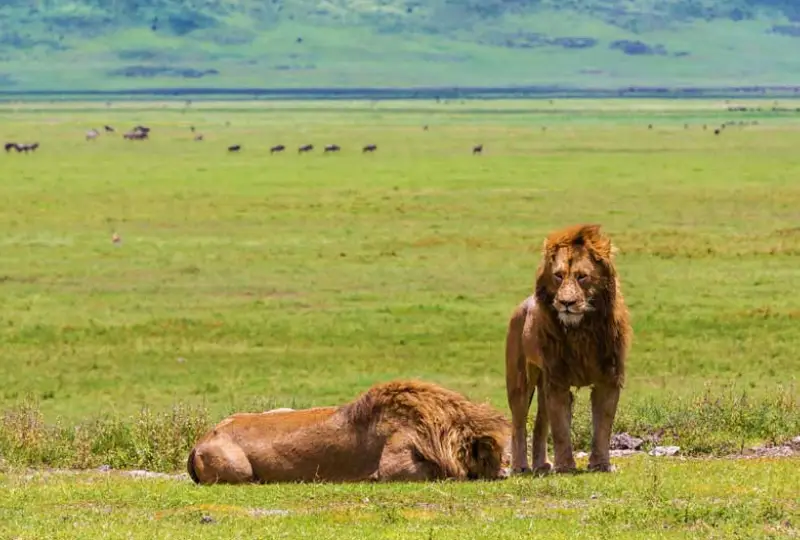Ngorongoro Conservation Area Overview
The Ngorongoro Conservation Area (NCA) in northern Tanzania is one of Africa’s most iconic safari destinations and a UNESCO World Heritage Site, celebrated for its unique combination of stunning landscapes, abundant wildlife, and rich cultural heritage. At the heart of the conservation area lies the Ngorongoro Crater, the world’s largest intact volcanic caldera, spanning approximately 260 square kilometers. This natural amphitheater offers breathtaking scenery with steep crater walls and a lush floor teeming with wildlife, providing one of the most accessible and rewarding safari experiences in Africa.
Ngorongoro is home to one of the highest concentrations of animals on the continent, including the Big Five lion, elephant, buffalo, leopard, and the endangered black rhino. Herds of zebras, wildebeests, and gazelles graze the crater floor, while hippos thrive in its freshwater lakes, and flamingos add splashes of color along the water’s edge. Predators, such as lions, cheetahs, and spotted hyenas, move across the savannah, creating dramatic wildlife encounters for visitors. Birdwatchers are also rewarded with over 500 bird species, ranging from raptors to colorful endemic species.
The Ngorongoro Conservation Area is also a cultural treasure. The Maasai people live within the area, herding their cattle alongside wildlife in one of the few regions where humans and animals coexist in a protected ecosystem. Travelers can visit Maasai villages to experience traditional dances, crafts, and daily life, adding a meaningful cultural dimension to the safari. The region also includes Olduvai Gorge, known as the “Cradle of Mankind,” where some of the earliest evidence of human evolution was discovered. Beyond game drives, visitors can hike along crater rims, explore scenic highlands, and enjoy immersive photographic opportunities, making Ngorongoro a multifaceted destination for adventure, wildlife, and history enthusiasts alike.
What makes Ngorongoro Crater so special?
Ngorongoro Crater is the world’s largest intact volcanic caldera, formed approximately two to three million years ago. Its uniqueness lies in its ability to sustain a dense population of wildlife within a relatively small area while maintaining spectacular scenery. Unlike other safari destinations, Ngorongoro combines wildlife, geology, and human history in a single, easily accessible location, providing one of the most concentrated and rewarding safari experiences in Africa.
Can I see the Big Five in Ngorongoro?
Yes, Ngorongoro is one of the best places in Africa to see the Big Five in one location. Lions, elephants, and buffalo are regularly sighted, leopards are occasionally spotted in rocky outcrops, and black rhinos rare in most other parks can often be observed within the crater. Game drives almost guarantee sightings of multiple species in a single day, making it ideal for first-time safari travelers and wildlife photographers.
How many days should I spend in Ngorongoro Conservation Area?
A one-day visit allows for a full exploration of the crater floor, which can include multiple game drives and wildlife sightings. However, staying two to three days is highly recommended for a more comprehensive experience. Extra days provide opportunities to visit Maasai villages, explore Olduvai Gorge, hike the crater rim, and enjoy birdwatching in the highlands. Multi-day visits offer a deeper understanding of both the natural and cultural significance of the area.
What is the best time to visit Ngorongoro?
Ngorongoro is a year-round safari destination, but the experience varies by season. The dry season (June to October) is ideal for wildlife viewing, as animals concentrate around water sources and vegetation is sparse. The wet season (November to May) transforms the landscape into lush greenery, ideal for photography, birdwatching, and witnessing the wildebeest calving season in the nearby Serengeti. Each season offers unique advantages, depending on whether visitors prioritize wildlife visibility or scenic landscapes.
Is Ngorongoro suitable for family safaris?
Absolutely. Ngorongoro is highly family-friendly due to its accessibility and manageable size. Game drives are relatively short compared to larger parks, making them suitable for children. Families can also enjoy cultural experiences with the Maasai, scenic walks along crater rims, and educational visits to Olduvai Gorge, creating a rich, engaging, and safe safari experience for all ages.
What other activities can I do in Ngorongoro besides game drives?
Beyond traditional game drives, visitors can hike along the crater rim, offering panoramic views of the savannah below. Birdwatching is excellent throughout the year, with numerous endemic and migratory species. Cultural tours to Maasai villages provide insight into local traditions and crafts. For history enthusiasts, exploring Olduvai Gorge offers a fascinating glimpse into human evolution, making Ngorongoro not only a wildlife haven but also a cultural and educational destination.
Can Ngorongoro be combined with other parks?
Yes, Ngorongoro is part of Tanzania’s Northern Safari Circuit and is commonly combined with Serengeti National Park, Lake Manyara, and Tarangire National Park. This allows travelers to experience a diversity of ecosystems, from the crater’s dense wildlife and Maasai culture to the Serengeti’s vast plains and Tarangire’s elephant herds, creating an unforgettable, well-rounded safari itinerary.

